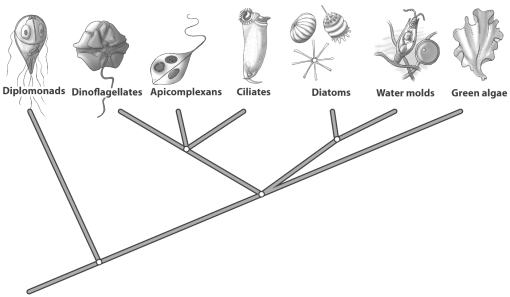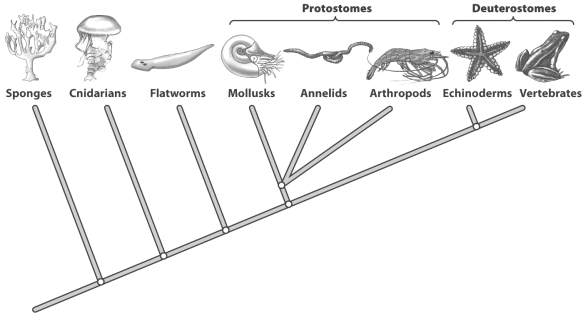A) separate male and female protists within the same species mate.
B) females of one protist species mate with males of another protist species.
C) special cells called gametes fuse together to produce a new individual.
D) an individual splits into two individuals that then mate with one another.
Correct Answer

verified
Correct Answer
verified
True/False
Seeds contain the embryos of plants and nutrients to assist with germination and initial growth.
Correct Answer

verified
Correct Answer
verified
True/False
Aerobic organisms can survive without oxygen.
Correct Answer

verified
Correct Answer
verified
Multiple Choice
No single characteristic is sufficient to describe a kingdom, for example, plants and some bacteria share in common
A) the ability to photosynthesize.
B) the presence of a cell wall and the absence of a plasma membrane.
C) a heterotrophic lifestyle.
D) the ability to reproduce sexually.
Correct Answer

verified
Correct Answer
verified
Multiple Choice
Which of the following would you most likely find surviving in a boiling-hot spring?
A) an archaean
B) bacteria
C) a eukaryote
D) none of the above
Correct Answer

verified
Correct Answer
verified
Short Answer
In nature, fungi function primarily as _______, getting their nutrition from dead and dying organisms.
Correct Answer

verified
Correct Answer
verified
Multiple Choice
Life on earth appears to have began in the water; the first organisms believed to colonize land were
A) bacteria.
B) fungi.
C) plants.
D) animals.
Correct Answer

verified
Correct Answer
verified
True/False
The organisms found living inside boiling-hot geysers can be described as thermophiles.
Correct Answer

verified
Correct Answer
verified
Multiple Choice
Which of the following terms describes organisms that can survive in extremely salty environments?
A) thermophiles
B) halophiles
C) methanogens
D) none of the above
Correct Answer

verified
Correct Answer
verified
Multiple Choice
In addition to the Bacteria, which other kingdom is comprised exclusively of prokaryotic organisms?
A) Archaea
B) Fungi
C) Protista
D) Plantae
Correct Answer

verified
Correct Answer
verified
Multiple Choice
Honeybees have declined dramatically within the United States in recent years, but it's important to note that the honeybee is not a native species; it is native to Asia. If the honeybee disappears entirely,
A) native pollinators will quickly replace it, both restoring the natural ecological order and maintaining normal plant pollination.
B) existing insects will quickly evolve to take advantage of the lack of competition for nectar and pollen in its absence.
C) plants will quickly evolve different methods of pollen dispersal, like wind pollination, to avoid extinction themselves.
D) farming will have to significantly change since most modern crops are horticulturally modified and poorly pollinated by native species.
Correct Answer

verified
Correct Answer
verified
Multiple Choice
Prokaryotes obtain their nutrition in a variety of ways; all of the following methods except ______ have been observed.
A) consuming other organisms
B) acquiring carbon from nonliving sources
C) using noncarbon-based nutritional systems
D) photosynthesis
Correct Answer

verified
Correct Answer
verified
Multiple Choice
Cells carry out many chemical processes, some of which produce toxic by-products. If you were designing a cell from known components, which of the following would provide the best method of protecting the cell from its own toxic by-products while allowing it to complete the chemical reactions necessary for life?
A) modify the cell membrane so that the toxin could diffuse to the outside of the cell but not reenter
B) isolate the toxin-producing reactions within an organelle
C) improve the photosynthetic process to produce more energy
D) devise a noncarbon-based cellular chemistry
Correct Answer

verified
Correct Answer
verified
Multiple Choice
Examine the evolutionary tree pictured below.  One prediction based on the arrangement of ciliates in the illustration is that the DNA of
One prediction based on the arrangement of ciliates in the illustration is that the DNA of
A) the green algae would share more in common with the plants than with the diplomonads.
B) the diatoms and water molds would be more similar to one another than any other protist.
C) the diplomonads would constitute a large percentage of the DNA of all other protists.
D) All of the above predictions are reasonable.
Correct Answer

verified
Correct Answer
verified
Short Answer
The ________ were the first plant group to evolve a vascular system.
Correct Answer

verified
Correct Answer
verified
Multiple Choice
The main body of a fungus is known as the
A) mycelium.
B) mitochondrion.
C) gymnosperm.
D) septum.
Correct Answer

verified
Correct Answer
verified
Multiple Choice
Resolving the relationship between the various kingdoms has been challenging because species often resemble one another; for example, the _______ contain some organisms that are animal-like and others that are plant-like.
A) bacteria
B) fungi
C) archaeans
D) protists
Correct Answer

verified
Correct Answer
verified
Multiple Choice
Taxonomy is the subdiscipline in biology that classifies living organisms; at the present time
A) all living organisms have been discovered, named, and their relationships to other organisms described.
B) humans have just finished a complete count of the number of species on Earth.
C) the diversity of organisms on Earth is not completely known and estimates of the number of unknown species vary 10-fold.
D) there is no consensus regarding the proper classification system of currently known organisms.
Correct Answer

verified
Correct Answer
verified
True/False
Without angiosperms, mosses could not reproduce.
Correct Answer

verified
Correct Answer
verified
Multiple Choice
The figure below shows the vertebrates and arthropods to be distantly related, yet each has features, like limbs and jaws, seen in no other groups.  How can such an obvious similarity be discounted in favor of embryological development as a basis for classification?
How can such an obvious similarity be discounted in favor of embryological development as a basis for classification?
A) The decision to overlook certain features reveals the arbitrary nature of classification and explains why there is so little agreement among taxonomists.
B) Limbs are not discounted by taxonomists; they were acquired from a common ancestor but later lost by the mollusks, annelids, and echinoderms.
C) Embryos are securely protected during development and have little need to evolve; shared inherited features indicate a common ancestor.
D) Examination of the embryos of all animals with body cavities reveals limbs, but they are unnecessary for some lifestyles and so they degenerate.
Correct Answer

verified
Correct Answer
verified
Showing 21 - 40 of 74
Related Exams